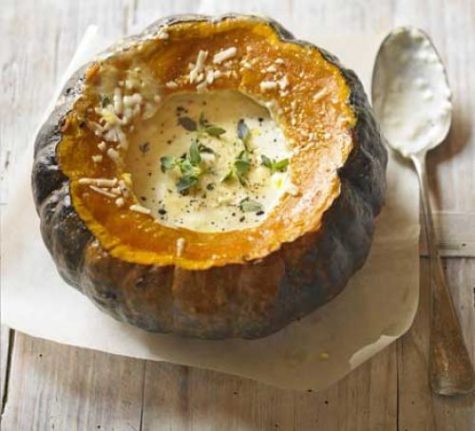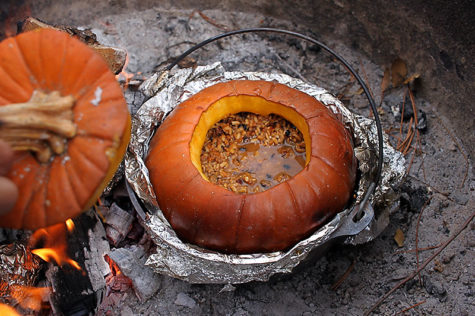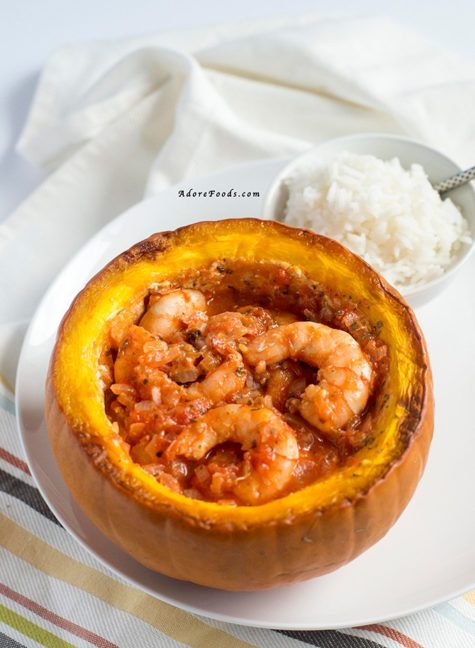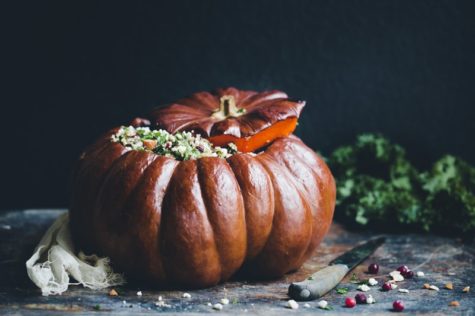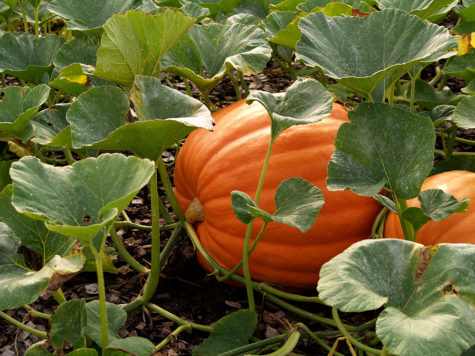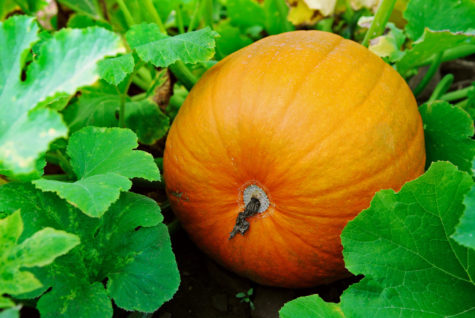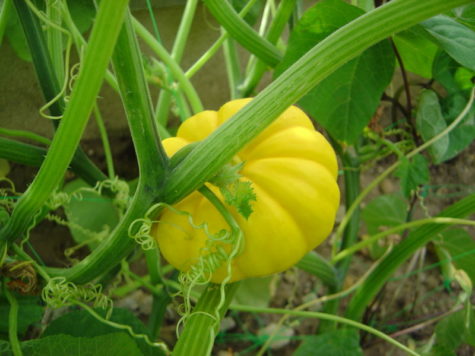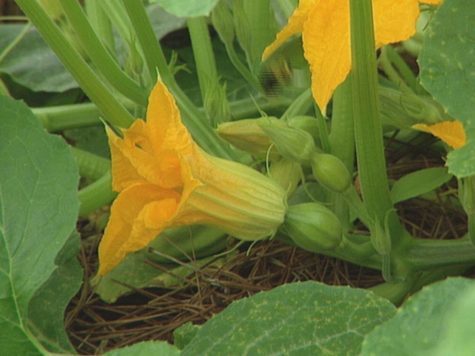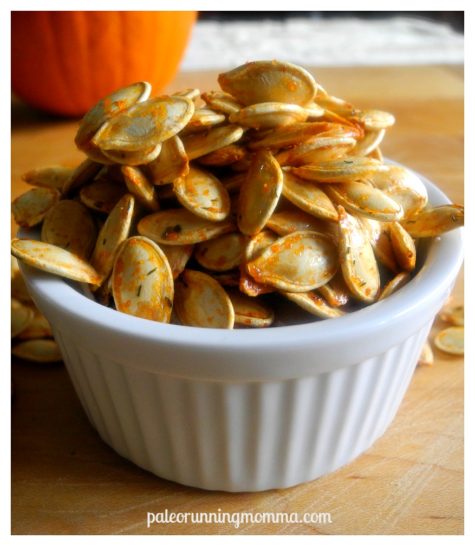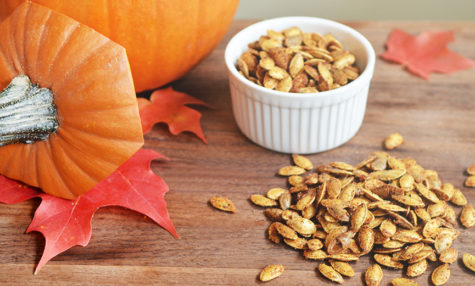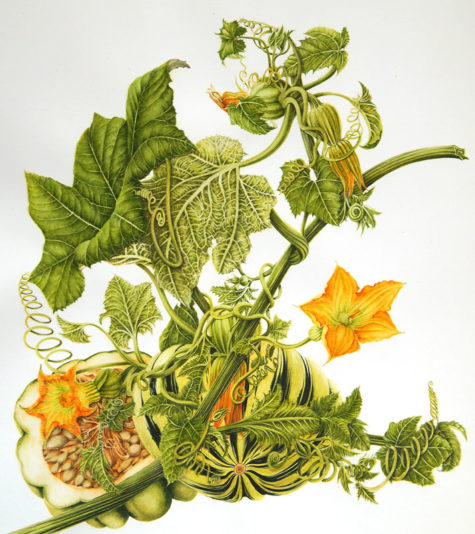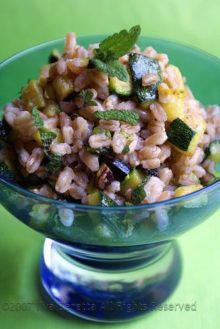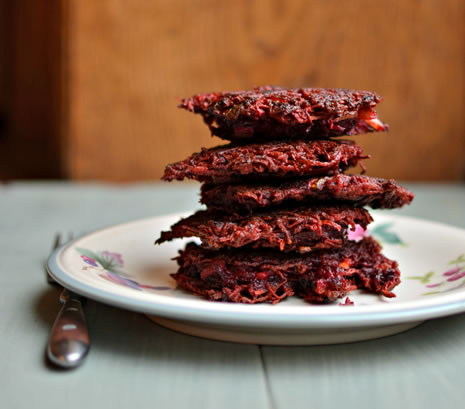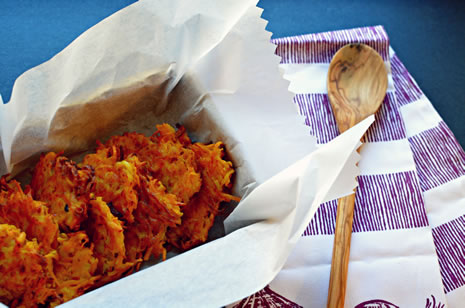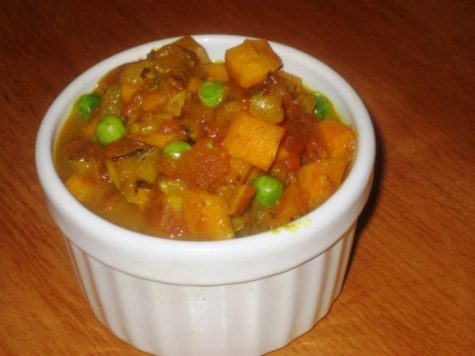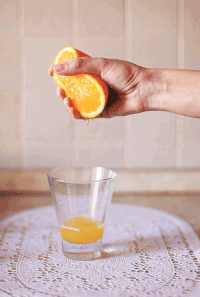Veggies
Roast Pumpkin with Cream and Parmesan
Ingredients
- 1½ kg pumpkin
- 300ml pot double cream
- 150ml milk
- 3 garlic cloves, crushed
- 2 tsp thyme leaves
- 85g grated parmesan
Method
Heat oven to 150C/130C fan/gas 2.
Cut lid off pumpkin and scoop out seeds and strands. Put the pumpkin on a baking tray. Meanwhile, heat the cream, milk, garlic and most of the thyme, with plenty of seasoning. When hot, pour into the pumpkin and stir in 50g of the Parmesan. Put on the lid.
Bake for 1½ hrs, take from the oven, then turn up the heat to 200C/180C fan/ gas 6. Remove the lid, sprinkle with pepper and the rest of the cheese, then bake for 15 mins more until golden. Scatter over the remaining thyme leaves. Scoop the pumpkin flesh into bowls with the cheesy cream and serve with crusty bread as a starter.
Recipe from BBC Good Food
Campfire Roasted Pumpkin Rice
- 9 inch sugar pumpkin (with a nice big stem)
- 2 cups arborio rice
- 4 – 4 ½ cups vegetable broth
- ½ tsp salt, plus more to taste
- 2 tablespoons butter
- ½ cup dried apricots, chopped
- ½ cup walnuts, chopped
- ½ cup dried barberries (see note below)
Tools needed:
- Campfire
- Foil
- Medium pot
- 10 inch / 4 quart Dutch Oven
- 10 inch Cast Iron Skillet
- Lid lifter
Do At Home:
Make sure the pumpkin fits in your dutch oven! It should sit comfortably inside the dutch oven diameter-wise. Soak barberries in warm water for 10 minutes and then drain.
Melt butter in a skillet set over medium heat. Add the dried apricots, walnuts and barberries. Cook until the fruit is softened, stirring often, about 5 minutes. Remove from heat and set aside.
In a pot, bring 4 cups of broth to a boil and add the arborio rice with ½ teaspoon of salt. Simmer with lid slightly ajar until rice is cooked, approximately 20 minutes. Check rice after about 10 minutes and make sure there is still some liquid. Add ¼ to ½ cup of water or broth if necessary.
Add nut and fruit mixture to rice and mix well. Add salt to taste if mixture still needs seasoning. Pack in water tight container or gallon sized zip top bag and store in cooler.
Do at campsite:
Get a nice campfire going to build a bed of hot coals.
Wash and dry pumpkin. Cut a lid around the stem and set aside. Scrape out insides of pumpkin leaving only the firm flesh.
Set the pumpkin in the dutch oven and scoop the rice filling into it. Don’t over fill the pumpkin – the pumpkin lid should still close tightly.
To cover the pumpkin and create an oven-like condition, use a 10 inch cast iron skillet as an improvised lid by turning it upside down and placing over the dutch oven. If the pumpkin is too tall, get creative and build a foil cover that will be easy to open/remove and put back on (you’ll need to check in on the pumpkin during the process).
Set the dutch oven directly in the fire pit with coals using your lid lifter. Place hot coals on top of the cast iron lid. Rotate ¼ turn every 15 minutes until pumpkin outside is slightly soft to the touch and the inside flesh is soft.
Remove from the campfire and set on heat-proof surface. Using a big spoon, scoop up rice, scraping up bits of pumpkin at the same time. Serve immediately.
- Note: Barberries have a unique tart-like flavor and are commonly found at Middle Eastern grocers. If you can’t find them, substitute currants soaked in lemon juice.
Makes: 8 servings
From: The Dirty Gourmet
Brazilian Shrimp Stuffed Pumpkin
Camarao na Moranga
Ingredients:
- 1 medium pumpkin
- 4 tablespoons olive oil, divided
- 1 pound wild caught large shrimp (prawn), cleaned and deveined
- 1 medium onion, finely chopped
- 1 jalapeño pepper, chopped
- 2 garlic cloves, minced
- 4 large ripe tomatoes, chopped
- ¼ cup fresh cilantro, finely chopped
- 1 cup cream cheese
- salt and pepper
Instructions:
Preheat oven to 350F/ 180C.
Wash the pumpkin and cut off the top. Scoop out the flesh and remove all seeds. Wrap it in aluminum foil and place it onto a baking tray, cut-off side down. Bake for about 40-50 minutes, until it is nearly soft. Remove it from the oven and unwrap from aluminium foil. Set aside.
In a large pan, heat olive oil on medium heat. Sauté the onion for 2-3 minutes, until golden. Add garlic, chopped jalapeño and cook for 3-4 minutes. Add shrimp to the pan and continue cooking for another minute. Add chopped fresh tomatoes, season with salt and pepper. Cook, stirring occasionally, until tomatoes are soft, for approximately 5 minutes. Remove from heat and add fresh cilantro. Set aside.
Using a spoon, spread the cream cheese inside the pumpkin, trying to coat all the inside area. Pour shrimp stew into the pumpkin and return to the oven. Bake for another 20 minutes, or until cheese melts and pumpkin becomes really soft inside. Remove from oven, sprinkle some more fresh cilantro on top. Serve warm with white rice on the side.
Makes: 4 servings
Source: Adore Foods
All Saints’ Day Pumpkin
Calabaza de Todos Los Santos
In the Basque countries, Spanish and French, the pumpkin is also associated with the supernatural feeling of the Halloween season. This dish is traditionally found on November the 1st in many peasant homes.
Ingredients:
- 1 large pumpkin
- 1 lb rice, uncooked
- 2 cloves garlic
- 1 large green pepper
- 2 lbs medium shrimps, sautéed in butter
- 1 tbsp grated onion
- 2 tbsp butter
- salt and pepper to taste
Clean and de-vein shrimps, chop green pepper and garlic. Sauté in 1 tablespoon butter and add onion. Cut the top from pumpkin, remove all the seeds.
- Note: Save the top to use as a lid.
Place rice in pumpkin, put the rest of the ingredients on top of the rice, and sprinkle with salt and pepper. Attach the lid with toothpicks. Place pumpkin on baking tray and bake in a 325 oven for 1 – 2 1/2 hours. To serve, remove the lid and scoop out the pumpkin / rice / shrimp mixture. Serves 6 to 8.
From: Authentic Spanish Cooking
Pumpkin
If you want to look and feel beautiful, consider including pumpkin as part of your diet.
Pumpkin has a range of fantastic health benefits, including being one of the best-known sources of beta-carotene. Beta-carotene is a powerful antioxidant. It also gives orange vegetables and fruits their vibrant color. The body converts any ingested beta-carotene into vitamin A.
Beta-carotene is a powerful antioxidant. It also gives orange vegetables and fruits their vibrant color. The body converts any ingested beta-carotene into vitamin A. Consuming foods rich in beta-carotene may reduce the risk of developing certain types of cancer, offer protection against asthma and heart disease, and delay aging and body degeneration. Pumpkins are also a powerful source of fiber.
The potassium contained within pumpkins can have a positive effect on blood pressure. The antioxidants in pumpkin could help prevent degenerative damage to the eyes.
Many studies have suggested that eating more plant foods such as pumpkin decreases the risk of obesity and overall mortality. It can also help prevent diabetes and heart disease, and promote a healthy complexion and hair, increased energy, and a healthful body mass index (BMI).
Pumpkin has been implicated in helping with the following:
- Aids in weight loss (due to fiber content)
- May reduce cancer risk (due to the antioxidant beta-carotene)
- Protects the skin (due to carotenoids)
- Sharpens eyesight (due to high levels of vitamin A)
- Maintains prostate health (due to zinc content of seeds)
- Helps boost mood and prevent depression (due to tryptophan content in seeds)
- Improves heart and muscle function (due to potassium and magnesium content)
- Improves immune system (due to zinc and vitamin C content)
- Helps expel intestinal worms (due to cucurbitins)
More on this “super” food can be found here: Encyclopedia of Herbology: Pumpkin
Pumpkin – It’s What’s For Dinner:
The edible parts of a pumpkin are the leaves, fruit and the seeds. High nutrients and medicinal properties in pumpkin leaves, fruit and seeds make it an attractive health food proposition.
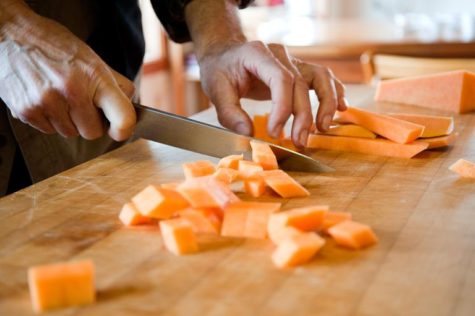
The pumpkin’s flesh can be either sweet or bitter, and it is commonly used in pies, scones, soups, stews, and other recipes.
- Pumpkins are high in protein and fiber, but low in fat. They are an excellent source of iron and vitamin A.
- Cooked pumpkin provides about 20 calories and 4.90 g of carbohydrates per 100 g serving.
The young fruit of a pumpkin is best used in savory entrees and sides, while the mature fruit goes best in pies and other sweet desserts. Medium-sized varieties, like ‘Autumn Gold’, ‘Jack-o-Lantern’, and ‘Spirit’ are among the best for culinary use; however, larger varieties like ‘Big Tom’ and ‘Jackpot’ are also popular.
When ripe, the pumpkin can be boiled, steamed, or roasted. Pumpkins that are still small and green may be eaten in the same way as pumpkin or zucchini.
In addition the fruit can be baked by cutting it into two halves, scooping out seeds and placing the hollow side down in a big tray followed by baking in an oven.
Preparing fresh pumpkin at home will deliver the most benefits for your health, but canned pumpkin is also a great choice. Pumpkin retains many of its health benefits in the canning process.
Pumpkin pie is a sweeter way to incorporate the benefits of pumpkin into the diet. Be sure to make a pumpkin puree rather than buying pre-made. Steer clear of canned pumpkin pie mix. This is usually placed next to the canned pumpkin in grocery stores, and is sold in a similar can. It contains added sugars and syrups.
- Canned pumpkin should have only one ingredient: Pumpkin.
Pumpkin is a highly nutrient-dense food. It is rich in vitamins and minerals but low in calories. Pumpkin seeds, leaves, and juices all pack a powerful nutritional punch. Although the variety of pumpkins that usually ends up carved into a jack-o-lantern is perfectly edible, it is best to cook with the sweeter and smaller sweet or pie pumpkin varieties.
Make sure the pumpkin has a few inches of stem left and is hard and heavy for its size. Store uncut pumpkins in a cool, dark place for up to 2 months.
The most common preparation methods of pumpkin involve desserts like custards and pies. One of the simplest ways to enjoy the contents is to gently roast or dehydrate the seeds in sea salt and other preferred spices.
There are many ways pumpkin can be incorporated into desserts, soups, salads, preserves, and even as a substitute for butter.
- Use pumpkin puree or canned pumpkin in place of oil or butter in any baking recipe.
- Make a quick treat of pumpkin chocolate yogurt by combining Greek yogurt, pumpkin puree or canned pumpkin, honey, cinnamon, and cocoa powder.
Harvesting and Preparing the Flowers
Pumpkin flower blossoms have a light, buttery taste. They are sometimes prepared as vegetables in a number of pasta, soup, and salad recipes.
The female blossoms will become the fruit so in order to preserve your harvest, it is best to pick the male blooms. Being aware of the difference between male and female blooms is important to know when picking pumpkin blossoms.
Male pumpkin blossoms are hairier and have a thin base where they attach to the stem. Females have a thick bulge, which is the ovary, where they grow from the plant.
Morning is the best time for harvesting pumpkin flowers. Choose male flowers when they are still in bud form. Male flowers grow first on the plant but the fully formed blooms are hairy and difficult to handle in the kitchen. Female blooms are considered the tastiest but you should minimize their harvest if you want fruit on the plant.
Give a gentle squeeze to the back of the bloom when picking pumpkin flowers. This will help you detect the bulb of a female or the flat end of a male flower.
- How to Store Pumpkin Blossoms:
The optimum condition is to use them the day of harvest. Picking pumpkin flowers and then using them immediately gives you the freshest taste of spring. Pumpkin flowers are very delicate and don’t store for long. However, there is a trick on how to store pumpkin blossoms for best flavor and to extend the life of the blooms. Keep them in the refrigerator. Male blooms last the longest and can be stored in the refrigerator for up to a week. Either sex will keep best if laid out gently on tissue or a paper towel on a dish or flat container.
- How To Prepare Pumpkin Blossoms:
Pumpkin fresh flowers add flavor to salads. Eaten as a side dish, the recipe is as follows: Pick flowers when vines are blooming, wash and roll in paper towel to dry. Dip in beaten egg, roll in fine bread or cracker crumbs and fry in buttered pan.
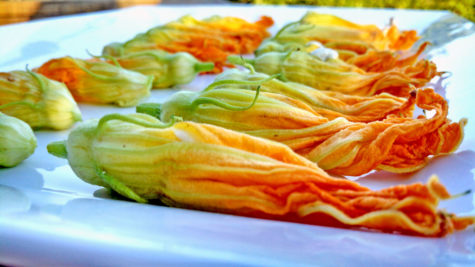
In the southwestern United States and Mexico, pumpkin and pumpkin flowers are a popular and widely available food item. They may be used to garnish dishes, and they may be dredged in a batter then fried in oil.
Pumpkin blossoms are flavorful and colorful when used as a garnish on salads. Remove the anthers inside, wash, dry the flowers, and use them whole or chopped. Stuff the blooms with rice, herbs or cheese when cooking with pumpkin flowers. You can also pickle, deep fry, or can pumpkin blossoms. If you cook the flowers, you can freeze them.
The flowers can be eaten straight off of the plant, added them into a salad, and for a nice breakfast treat, they can be dipped into pancake batter, cooked in a skillet.
Whichever method you choose, prepare the blooms as quickly as possible for best flavor and texture. Harvesting pumpkin flowers is easy and a great way to put the male blooms to use rather than having them simply fall from the plant to waste away.
Harvesting and Preparing the Leaves
Pumpkin leaves are edible. They are chock-full of iron, and may be prepared like other dark green, leafy vegetables. How do they taste? Here’s a review:
“The pumpkin greens lacked any bitterness that other greens tend to have, which surprised me. These might be the sweetest greens I have eaten. Even my son and wife enjoyed them. The flavor reminded me of a mixture of green beans, broccoli, spinach and asparagus.”
Italian pasta recipes include the leaves and stems, blanched briefly, then fried with oil and garlic before being tossed with chopped tomatoes. The Malaysian dish Pucuk Labu combines smaller, tender pumpkin leaves and shoots with anchovies, garlic and sliced onions, all simmered in rich coconut milk.
Pick the young-medium aged leaves (not the older tougher ones), and use them in cooked recipes like you would a spinach or a heavy winter green.
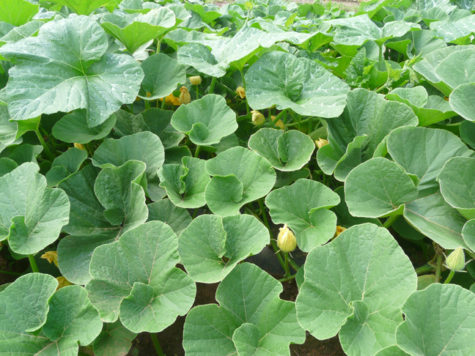
Covered in fuzz and possessing a thick, fibrous spine, pumpkin leaves aren’t all that intuitively edible. They take a little bit of advance preparation before you can use them in recipes.
Here is a simple method:
“Holding the leaf upside down by its stem, you see that the stem is hollow. Use your thumbnail to split half or a third of the stem and snap it backward so that the flesh breaks cleanly, but the outer fibers do not. Pull gently, removing the fibers from the outside of the stem and the back of the leaf. Repeat until you have de-strung a good pile, because, like all greens, pumpkin leaves cook down quite a bit.”
Once you’ve de-strung a pile of pumpkin leaves, you can cook them in a variety of ways. In Malawi, they are often simmered simply with tomatoes just for a few minutes until the leaves are tender.
Harvesting and Preparing the Seeds
Pumpkin seeds are a good source of plant protein, high mineral content, and vitamin F.
Traditional folk medicine touts pumpkin seeds as an effective treatment for prostate enlargement. Anti-inflammatory agents, known as phytosterols, combine with the healing properties of zinc to potentially reduce the size of the prostate.
Pumpkin seeds are just about the richest natural sources of zinc nutrition ever found. The use of pumpkin seeds for their beneficial effect on the prostate gland is as old as the ages. (Referred to as He-man power).
Pumpkin seeds are usually roasted and consumed as healthy, protein-packed snacks.
To harvest your pumpkin seeds, slice open your pumpkin (to eat or to make as a jack-o-lantern). Scoop out the seeds with your hands or a large, sturdy spoon. Place the seeds in a bowl. *Some pumpkin varieties have seeds with white husks over the nut meat, and some just contain the green nutmeat, aka “pepitos.”
You can process and eat pumpkin seeds the same way, regardless of the variety.
Heat a frying pan and add enough high heat vegetable oil (we like organic sunflower, grapeseed, or raw coconut oil) to sauté them. Once the pan is hot, add the pumpkin seeds. *Don’t worry if there is a little bit of pumpkin string still attached, this cooks up fine and adds some nice flavor & nutrition.
As soon as the seeds are in the pan, add some fresh ground sea salt. Stir repeatedly to ensure light, even browning uniformly on the seeds’ surfaces. Let them cool down, but eat them while they’re still warm for best flavor! They’ll also store for a long time and make a great, healthy alternative to potato chips.
Nutritional breakdown
According to the USDA National Nutrient Database, one cup of cooked, boiled, or drained pumpkin without salt contains:
- 1.76 g of protein
- 2.7 g of fiber
- 49 calories
- 0.17 g of fat
- 0 g of cholesterol
- 12.01 g of carbohydrate
This amount of pumpkin also provides:
- more than 200 % of the recommended daily allowance (RDA) of vitamin A
- 19 % of the RDA of vitamin C
- 10 % or more of the RDA of vitamin E, riboflavin, potassium, copper, and manganese
- at least 5 % of thiamin, B-6, folate, pantothenic acid, niacin, iron, magnesium, and phosphorus
In addition to the meat, one can also consume the green seeds inside their shell, which also provides a concentrated dose of nutrition, such as:
- An excellent source of vitamin K
- Rich in riboflavin, folate, thiamin, B6, and niacin
- Good source of vitamin A
- Excellent source of manganese, magnesium, phosphorus, iron, copper, zinc, and potassium
- Contains beneficial amounts of selenium
- Excellent source of healthy fats and dietary fiber
- Quality source of vegan protein (1 ounce yields 7 grams of protein)
Around The World
Pumpkin leaves are traditional vegetables of choice to many communities in Africa, North America and Asia. This is because of their ease of availability, rich in nutrients and less demanding husbandry. The leaves are normally mashed with potatoes, maize, beans and bananas to make a delicious meal.
- In Tanzania, pumpkin leaves, peanut butter, onion, chili and coconut cream are nicely blended to make a soup called ‘M’chicha Wa’nazi’.
- In Kenya, ‘Mukimo’ is a delicacy prepared by mixing well cooked maize, peeled potatoes and mashing them together with pumpkin leaves and sometimes boiled pumpkin fruit slices.
- In the Middle East, pumpkin is used for sweet dishes; a well-known sweet delicacy is called halawa yaqtin.
- In South Asian countries such as India, pumpkin is cooked with butter, sugar, and spices in a dish called kadu ka halwa.
- Pumpkin is used to make sambar in Udupi cuisine.
- In Guangxi province, China, the leaves of the pumpkin plant are consumed as a cooked vegetable or in soups.
- In Australia and New Zealand, pumpkin is often roasted in conjunction with other vegetables.
- In Japan, small pumpkins are served in savory dishes, including tempura.
- In Myanmar, pumpkins are used in both cooking and desserts (candied). The seeds are a popular sunflower seed substitute.
- In Thailand, small pumpkins are steamed with custard inside and served as a dessert.
- In Vietnam, pumpkins are commonly cooked in soups with pork or shrimp.
- In Italy, it can be used with cheeses as a savory stuffing for ravioli.
- In Nigeria, pumpkin leaves are used to make soup, cassava salad, plantain porridge and ‘Asaro or Ebe’ (yam pottage).
- Pumpkin leaves are also eaten in Zambia, where they are called chibwabwa and are boiled and cooked with groundnut paste as a side dish.
- Pumpkin leaves, usually of C. moschata varieties, are eaten as vegetable in Korean cuisine.
Borrowed from: Encyclopedia of Herbology
Lemony Zucchini With Farro
- 350 g/12.3 oz farro, you can also use brown rice
- 400 g/14.1 oz zucchini, diced
- 1 large lemon
- 4-5 tblsp chopped pistachio nuts
- A small bunch of lemon balm, finely chopped
- 1 clove of garlic, chopped
- Salt
- Olive oil
Boil the farro in abundant salted water until soft, it usually takes 20-30 minutes. Meanwhile you first either grate the zest of the lemon or you use a lemon zester and put it in a pan with the garlic and some olive oil.
Braise for a minute before adding the diced zucchini and go on braising until the zucchini is sift and golden. Add the pistachio nuts and the farro and then drizzle a little of lemon juice over it. Add the Lemon balm and stir. Serve!
Makes 4 servings.
Found at: Lucullian
Beet Latkes stuffed with Goat Cheese
Beets and goat cheese are a classic pairing, most typically found in salads, but I’ve given them a new spin in this latke recipe, and let me tell you—they are INCREDIBLE.
You’ll want to freeze the goats cheese slightly so that it doesn’t ooze out while frying, so that’s our first step. Slice the goats cheese thinly and put it in the freezer.
Now you’re ready to fry and assemble the latkes. Adding a piece of carrot to the oil any time you’re frying helps absorb the burnt taste. When the carrot starts to look shriveled, remove it and put in a fresh piece. It works. Trust me. I take my frying carrots very seriously.
Ingredients:
- 20 oz. shredded raw beets
- ½ a large onion, shredded or finely diced
- 2 eggs
- ¼ cup flour
- 1 tsp. kosher salt
- goat cheese (I used a 7oz. tube)
- oil for frying
Directions:
Finely slice the goat cheese into rounds and freeze for 15-20 minutes. Mix the shredded beets, onion, flour, eggs and salt. Pour 2-4 tbsp. of oil into the frying pan and heat on medium-high. Use a spoon, or a small measuring cup (1/8 cup) to scoop up the batter. Gently place a spoon of batter in the pan and flatten it. Place a piece of goat cheese on top of the batter, then cover the goat cheese with another scoop of batter. Fry for 3-4 minutes, then gently flip the latkes and fry for another 1-2 minutes on the second side. When ready, the latkes will be crisp on the outside and soft on the inside, with the goat cheese deliciously melted. Repeat until batter is finished.
Yields: 12 latkes.
Source: Chabad
Butternut Squash Sweet Potato Latkes
Instead of making sweet potato pie for Thanksgiving, and potato latkes for Chanukah, try these sweet potato butternut squash latkes. You’ll get the flavors of Thanksgiving but the crispy fried texture of Chanukah.
Two tips for latke making:
- Stick a small piece of carrot in the oil. The carrot absorbs the burnt taste the oil sometimes gets. When the carrot looks dark ad shriveled, take it out and replace with a new one.
- To make the latkes a uniform size, use a 1/3 cup measuring cup to scoop up the batter.
Ingredients:
- 1 butternut squash
- 2 Yukon Gold potatoes
- 1 large onion
- 1 sweet potato
- 4 eggs
- ½ to ¾ cup flour
- 2 tbsp. kosher salt
- Olive oil for frying
- Optional: If you’re serving these at a dairy meal, throw in ½ cup grated parmesan cheese
Directions:
Dice and sauté the onion in 2 tbsp. olive oil and ¼ tsp. salt. Peel and shred the butternut squash, sweet potatoes and potatoes. Mix all the ingredients in a large bowl. Heat olive oil in a non-stick frying pan. Scoop the batter using a measuring cup for uniformity. Drop into the hot oil (keep the flame on medium-high). Fry each latke until brown on one side—approximately 3-4 minutes. Flip and fry on the other side another minute or two, or until brown, on the second side. Remove from oil and drain on a paper towel. The paper towel soaks up the excess oil while keeping the latkes fresh. Repeat until all the batter has been fried.
Serve immediately—that is, if they make them out of the kitchen at all.
Note: Recipe makes approximately 30 medium latkes.
Source: Chabad
Potatoes with Lemon & Thyme
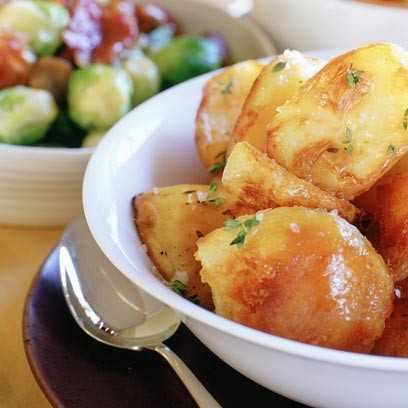 Warming lemon and pungent thyme with tender potatoes – delicious and good for you.
Warming lemon and pungent thyme with tender potatoes – delicious and good for you.
Ingredients:
- 1 leaves Bay Leaf
- 2 pinches Black Pepper
- 1/2 whole Lemon
- 2 whole Potatoes
- 2 pinches Salt (Mineral Salt is best)
- 1 tbsp Sunflower Oil
- 1 tsp Thyme (fresh)
Preparation:
Skin potatoes. Put potato, salt, bay leaf, and black pepper in a pot with 1 cup water. Steam covered until potatoes are tender. Cut into bite sized chunks and saute in sunflower oil. Chop thyme and sprinkle over just as potatoes begin to brown. Remove from heat, garnish with lemon juice and mix gently.
Source: Joyful Belly
Yam Curry
- 1 generous handful of fresh Mushrooms (sliced)
- 1 small Carrot
- 1 medium Yam
- 1/2 golden Onion
- 1 cup Green Vegetables (zucchini, peas, green beans)
- handful of Bean Sprouts
- Tomato (sliced)
- 1/2 cup (or more) Sour Cream
- 1 to 1 1/2 cups Water
- 1 tsp Curry Powder
- Cumin, Coriander, and/or Turmeric (to taste)
- Salt and Pepper (to taste)
- Flour Mixture
Fry the sliced mushrooms and the seasonings in oil until partly done. Add 1/2 cup of water and the Carrot, Yam, and Onion – all cut into long thin slices. Cook for a few minutes. Add the Green Vegetables and cook for about 5 minutes. Toss in the Bean Sprouts, and enough water to make gravy (about 1/2 to 2/3 cup). Dribble in the Flour Mixture, then add sliced tomato. Simmer one minute and remove from heat. Add the sour cream.
Flour Mixture:
In order to make a smooth gravy, mix 1 or 2 tablespoons of flour with enough water to make a smooth pasty liquid. Add a few drops at a time to the liquid in the pan in which you wish to make gravy. Stir constantly. Heat should be on low. Add salt and pepper. The smoother the flour used, the smoother the gravy.
From: Vegetarian Cookbook
